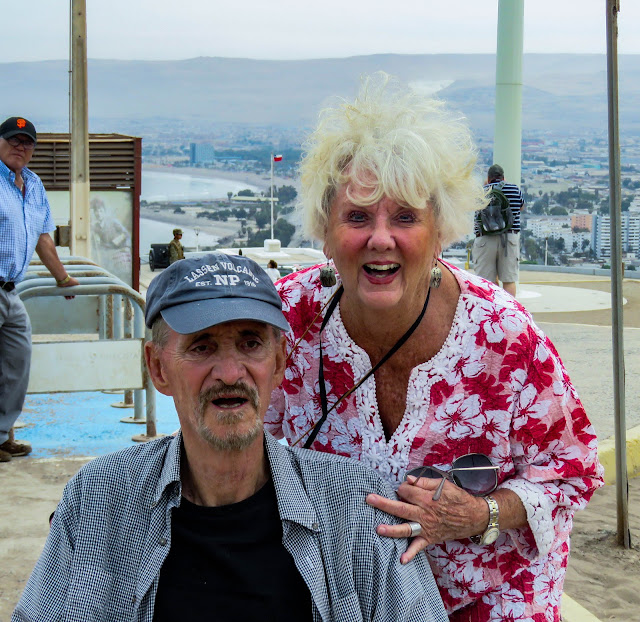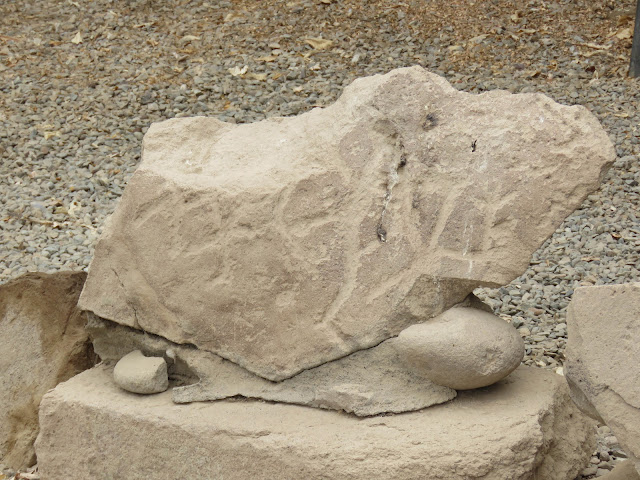We entered Chile early this morning, the last country in our
winter escape. After the mess up yesterday, I was hoping that things would go
smoothly today. But I had a sense that things were not right. I had heard
nothing from the tour operator about where and when we were going to meet, so I
notified Viator yesterday of this issue and asked them to contact the guide.
Just before it was time to disembark, I received an email that the guide was
“having problems with his vehicles” and would need to cancel. At least this
time we had some warning. We were not going to waste another day on the ship. I
had a good guidebook and a phone to call an Uber. I figured we could do this
one on our own.
Once again, the landscape here is so dry that it barely
seems possible people could live here. But the town of Arica is fairly large,
even though it scarcely looks any more affluent that Trujillo. Arica, I knew,
is not only the most northerly town in Chile, but serves as a base for
traveling deep into the Atacama Desert. I have been fascinated by the Atacama
Desert for years now. It is considered perhaps the best place on earth to see
what the night skies looked like hundreds of years ago. I knew that I would not
have the experience of being there on a clear, cold night on this trip, but I
had the sense of starting to get to know a place where I would like to return
some day.
The town is dominated by El Morro, a giant rock. I learned
from the guidebook that the decisive battle of the Pacific War took place here.
The Pacific War is not something Americans ever learn about in school. I cannot
remember all the facts perfectly, but basically one of Chile’s few profitable
industries in the late nineteenth century was mining saltpeter from the desert.
Saltpeter was an essential ingredient in making gunpowder, and the European
powers needed gunpowder for their colonial wars. Arica and the area around it
were then part of Peru. Bolivia and Peru wanted to get some of the foreign
currency that was flowing to Chile, so they blockaded sea access unless the
Chileans paid for it. Chile felt that this broke some agreement it had with
Bolivia and declared war. Peru came to the assistance of Bolivia. But even though Peru was a much stronger power, the Chileans defeated
the Peruvian forces and annexed this area to Chile. The decisive battle was
fought here when the Chileans forced their way to the Peruvian fort on the top
of El Morro. That is why they fly an enormous flag there. Peru is still angry
about it.
In the center of the town there is the usual square. Spanish colonial law mandated a fairly large open plaza in the center of each town where troops could be mustered and trained. That is why it is usually referred to as the Plaza de Armas. And the same law mandated that a church should sit on east side of the square with government buildings on an adjacent side. The church that current dominates the square is not colonial, however. It is the work of the famed Gustave Eiffel and was erected just before the Pacific War. Eiffel was a strong believer in modular iron buildings. This church was actually fabricated in France and shipped over in sections to be assembled and painted.
It’s hardly an architectural masterpiece. Minus the crucifix, it could easily be a railway station in some village in Lancashire.
I am not sure Eiffel had much sense of where the building was going to be, as he carefully placed lots of gutters on the roof and added their copper gargoyles to help with keeping water off the iron walls. It’s not a particularly necessary touch as Arica gets less than a half inch of rain a year. Death Valley gets far more than that.
The inside was filled with all the usual tacky stuff you would expect to find in a nineteenth century Catholic Church. At least this statue of The Sacred Heart was not make of cast iron.
Arica is hilly, and John and I gave up trying to climb a small hill to look at an archeological site. Instead, we called an Uber and went to the top of El Morro. Uber is interesting here. It is a free market dream. Instead of the app giving you a set fare, you have a suggested amount but are allowed to bid more or less than that. The driver can see what you are offering for where you want to go and either accept, reject, or provide a counteroffer. It’s called Uber Accuerdo, or “Uber Agreement.”
From the top of El Morro, you can get a panoramic view of
the entire area. It’s not like looking at London from the top of the Eye,
however. It’s dusty town with lots of single-story rebar and concrete houses.
The museum devoted to the heroes of the Pacific War did nothing for either me
or John. So we looked at the enormous flag and pondered where to go next.
At that moment, however, our friend Paula from the ship appeared. She’s one of the regulars at John’s afternoon meeting. I like her a lot. She spends most of the year traveling, and there is something about that I find incredibly appealing. .
We did not have a lot of time, but we felt like there was more to see. So we got an Uber to take us to a nearby village, San Miguel de Azapa, where there is a famous archeological museum.
It took about thirty minutes to get there. I decided not to worry too much about getting back. The first thing we saw was a collection of ancient petroglyphs. I cannot remember the name of the indigenous group who probably carved these into the rocks. There was some pretty good signage, but it was written only in Spanish and it fairly academic Spanish at that.
Inside the museum, there was a sequence of exhibits which traced the various groups who had lived in the area and their achievements in both arts and technology. I could get the gist of most of the explanations and I interpreted as best as I could for John.
The real reason everyone comes to this museum is to see
mummies. The people who lived here practiced a form of mummification – I think
that is a word – for centuries. They removed most of the internal organs and
most of the head. Clay was used to indicate certain body parts like breasts and
penises. The face was replaced by a clay circle. None of the faces had any expressions or showed any individual markings. They seemed generic.

I am not sure how successful this strategy was. Nobody seemed to be blowing car horns as they passed or giving thumbs up signs. We couldn’t stand the noise so we walked on. Another famous building here is the old Customs House.
Unless you plan to spend some time in the desert or go up to Lake Titicaca in Bolivia, there is no particular reason to visit Arica. But it was still glad we came and glad that we had the resolve to see it ourselves in the limited time available.













